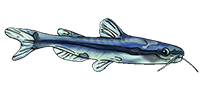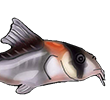Intergeneric pimelodid hybrids
- Silurus
- Posts: 12461
- Joined: 31 Dec 2002, 11:35
- I've donated: $12.00!
- My articles: 55
- My images: 896
- My catfish: 1
- My cats species list: 90 (i:1, k:0)
- Spotted: 428
- Location 1: Singapore
- Location 2: Moderator Emeritus
-
Viktor Jarikov
- Posts: 5596
- Joined: 26 Jan 2010, 20:11
- My images: 11
- My cats species list: 25 (i:0, k:0)
- Spotted: 4
- Location 1: Naples, FL
- Location 2: USA
Re: Intergeneric pimelodid hybrids
Very useful to know for my purposes. Thanks, HH.
Monitoring of the interspecific hybrid production and trade is essential for the appropriate management of these animals in fish farms. The identification of catfish hybrids by morphological analysis is unreliable, particularly of juveniles and post-F1 individuals. Therefore, in the present study, we used five molecular markers (four nuclear genes and one mitochondrial gene) to detect hybrids in the trade of pimelodid juvenile fish from different stocks purchased of five seed producers in Brazil. Samples commercialized as pintado (pure species Pseudoplatystoma corruscans) from three fish farms were genetically identified as hybrid cachapinta (♀ P. reticulatum x ♂ P. corruscans). In the stocks purchased as cachandiá (hybrid between ♀ P. reticulatum x ♂ Leiarius marmoratus) and cachapira (hybrid between ♀ P. reticulatum x ♂ Phractocephalus hemioliopterus), we suggested the occurrence of intergenus crosses involving the hybrid cachapinta, which was used instead of the pure species P. reticulatum. The problems involving the hybrid cachapinta production were discussed in the present study, especially because these animals have caused genetic contamination and threatened the genetic integrity of natural and cultivated populations. In order to improve the surveillance of the production and provide criteria for the correct management of catfish hybrids, genetic markers has become an excellent alternative to the morphological identification, including juveniles or post-F1 generations.
Monitoring of the interspecific hybrid production and trade is essential for the appropriate management of these animals in fish farms. The identification of catfish hybrids by morphological analysis is unreliable, particularly of juveniles and post-F1 individuals. Therefore, in the present study, we used five molecular markers (four nuclear genes and one mitochondrial gene) to detect hybrids in the trade of pimelodid juvenile fish from different stocks purchased of five seed producers in Brazil. Samples commercialized as pintado (pure species Pseudoplatystoma corruscans) from three fish farms were genetically identified as hybrid cachapinta (♀ P. reticulatum x ♂ P. corruscans). In the stocks purchased as cachandiá (hybrid between ♀ P. reticulatum x ♂ Leiarius marmoratus) and cachapira (hybrid between ♀ P. reticulatum x ♂ Phractocephalus hemioliopterus), we suggested the occurrence of intergenus crosses involving the hybrid cachapinta, which was used instead of the pure species P. reticulatum. The problems involving the hybrid cachapinta production were discussed in the present study, especially because these animals have caused genetic contamination and threatened the genetic integrity of natural and cultivated populations. In order to improve the surveillance of the production and provide criteria for the correct management of catfish hybrids, genetic markers has become an excellent alternative to the morphological identification, including juveniles or post-F1 generations.
Thebiggerthebetter
fish-story.com
fish-story.com
-
Viktor Jarikov
- Posts: 5596
- Joined: 26 Jan 2010, 20:11
- My images: 11
- My cats species list: 25 (i:0, k:0)
- Spotted: 4
- Location 1: Naples, FL
- Location 2: USA
Re: Intergeneric pimelodid hybrids
Perhaps, the Cat-eLog entry for the TSNxRTC hybrid catfish could use this info.
So the (in)famous and widespread hybrid TSN x RTC, which we used to think was P. fasciatum (mother) x RTC (father) may not be it...
... not only the TSN mother is not another species (not fasciatum but could be reticulatum) but on the TSN side an intragenus hybrid of reticulatum and corruscans is used, per:
In the stocks purchased as cachandiá ... cachapira (hybrid between ♀ P. reticulatum x ♂ Phractocephalus hemioliopterus), we suggested the occurrence of intergenus crosses involving the hybrid cachapinta, which was used instead of the pure species P. reticulatum.
So the (in)famous and widespread hybrid TSN x RTC, which we used to think was P. fasciatum (mother) x RTC (father) may not be it...
... not only the TSN mother is not another species (not fasciatum but could be reticulatum) but on the TSN side an intragenus hybrid of reticulatum and corruscans is used, per:
In the stocks purchased as cachandiá ... cachapira (hybrid between ♀ P. reticulatum x ♂ Phractocephalus hemioliopterus), we suggested the occurrence of intergenus crosses involving the hybrid cachapinta, which was used instead of the pure species P. reticulatum.
Thebiggerthebetter
fish-story.com
fish-story.com





